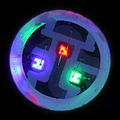
In the context of integrated circuits, a die is a small block of semiconducting material on which a given functional circuit is fabricated. Typically, integrated circuits are produced in large batches on a single wafer of electronic-grade silicon (EGS) or other semiconductor (such as GaAs) through processes such as photolithography. The wafer is cut (diced) into many pieces, each containing one copy of the circuit. Each of these pieces is called a die.
Contents

There are three commonly used plural forms: dice, dies, and die. [1] [2] To simplify handling and integration onto a printed circuit board, most dies are packaged in various forms.













